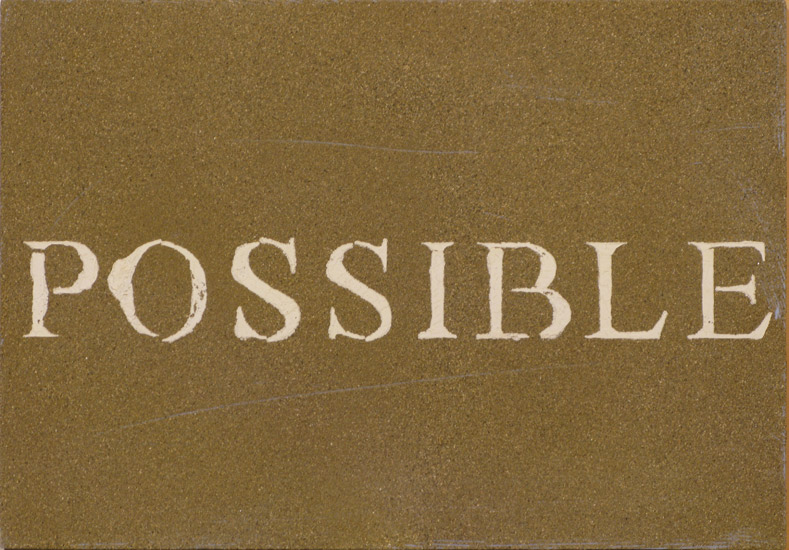
Possible, 1996 Affresco Cm 40 x 60
DOPPIOSENSO - Il senso del Doppio
Marcel Duchamp è l’artista che ha maggiormente giocato con il doppio senso soprattutto nei titoli dei suoi Ready-made. Secondo Duchamp non l’abilità tecnica, lavoro soltanto manuale, ma l’atto di scegliere, un’azione mentale, una diversa attitudine verso la realtà, aggiunge valore estetico all’opera. Fabrizio Ruggiero ritiene che l’abilità tecnica, possa essere un processo molto sofisticato, un’azione mentale molto profonda e che comunque lo scarto linguistico che produce una variazione di significato, spesso divertente, all’interno di un idioma, nulla abbia a che vedere con le arti visive. La pittura non è fatta di parole, la pittura non ha sonoro e concentrando la consapevolezza nello sguardo, nel solo senso della vista, la pittura ne amplifica la sensibilità. La pittura diventa soggetto che emana sensazioni, la pittura non si aspetta orecchie che ascoltano ma occhi che guardano e allora la pittura concentra il suo sonoro nel segno e nel colore. Questi esprimono anche l’indicibile … la pittura allude l’indicibile, qualcosa che s’intravede nascosto ‘tra’ o, meglio, ’al di là’ delle esperienze, ciò che non si può dire perché la pittura non ha parola ma ciò che può esprimere giacché la pittura è segno e colore, ciò che manca alla parola.
Nell’arco degli ultimi vent’anni, partendo da quest’idea, F.R. ha interpretato, di tanto in tanto, le cose di Duchamp come segni cui attribuire significati altri, utilizzandole come soggetti per affreschi che in questo modo acquistano un senso completamente diverso. Giocando con il culto ridondante dell’Art-Stars-System, ha raccolto gli studi preparatori per la veduta anamorfica di Nu descendant un escalier, celeste! (1989), quelli di Ariadne and Dionysus per A bruit secret & Pandora’s Box (2010) e il ritratto ad affresco Marcel Duchamp with piercings (2008) ed altri lavori sparsi nella grande Boîte-en-valise II, red. (2011).
DOPPIOSENSO-Double Meaning – the meaning of the double.
Boîte-en-valise II, red, 2011.
Marcel Duchamp is the artist who has played most with double-meaning especially when naming his Ready-made.
According to Duchamp, the mental action of actually choosing a different attitude towards reality adds an aesthetic value to the artwork, while technical skill is only a manual work. Fabrizio Ruggiero believes that technical skill can be a very sophisticated process, a deep mental action and, nonetheless, the linguistic gap producing a variation in meaning, often funny, inside an idiom, has nothing whatever to do with visual arts.
Painting is not done by words, painting has no sound, and focusing awareness in seeing, in the very sense of sight, painting amplifies its sensitiveness. Painting becomes a subject radiating vibrations, painting is not waiting for ears ready to listen but for eyes ready to look and so painting focuses its own “sound” on mark and color and both voice the inexpressible…Painting hints at the inexpressible, a glimpse of something that can be caught “in-between” or behind experience, something that cannot be told because painting has no words but that can be express by painting because it consists of mark and color, the very things that words are missing.
Starting with this concept, F.R. has used, from time to time over the last twenty years, Duchamp’s objects as signs which give a different meaning, using them as subjects for his frescoes. Playing with the redundant cult of the Art-Stars-System F.R. gathered the preparatory sketches for the anamorphic view of Nu descendant un escalier, celeste! (1989), the ones for Ariadne and Dionysus in the installation A bruit secret & Pandora’s Box (2010) and the fresco portrait Duchamp with piercings (2008) and other works in the capacious Boîte-en-valise II, red. (2011). |